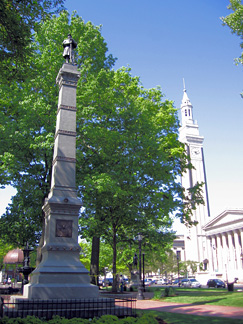resisting slavery
Springfield and the Civil War
Though Springfield contained an active abolitionist community, the Civil War underscored the conflicting opinions and feelings of local residents regarding the proper place of African Americans in U.S. society. A diary entry from Orrin W. Cook of Springfield, who served in the 22nd Massachusetts regiment as a lumberman, illustrates such ambivalence. At the height of the conflict in July of 1864, Cook wrote, "I think I should make a harsher master than most of these slaveholders do. I should not bear with these impudent, lying, thieving niggers. I am as strongly antislavery as ever, and even more anti-nigger."
Census records from 1860 indicate that 276 blacks lived in Springfield on the eve of the Civil War. This small community was mostly confined to the upper State Street area, called "Little Hayti," and to a neighborhood on Cross and Willow streets. When the Emancipation Proclamation was announced, the local black population held a celebration at City Hall and invited "all lovers of liberty" to attend. Springfield's black community also raised funds and collected clothing to send to the newly freed former slaves. 2
During the early years of the war, African Americans worked for the Union cause as masons and carpenters, cooks, steamboat pilots, scouts, nurses and spies. Federal law excluded black soldiers from Army service, but by 1862 Lincoln and his officers were considering the recruitment of former slaves. Following the Emancipation Proclamation in 1863, the Union organized the first regiments of black volunteers, and by the end of the war nearly 180,000 African-Americans served in the Army and another 19,000 in the Navy.
The first black regiment organized in the north was the 54th Massachusetts Volunteer Infantry. Several black soldiers from Springfield served in this regiment, including Peter Johnson, Eli Wilson, and William Oliver. Among the first Union troops to enter the fallen Confederate capital of Richmond in April 1865 were soldiers from the all-black 5th Massachusetts Cavalry, including Gustaves Booth of Springfield. Another 5th Cavalry member from Springfield, Isaac Dorsey, died of an illness before the war ended.
Black Soldiers in the Civil War were not accorded the same treatment as white soldiers. They were confined to segregated units, and suffered disparities in pay, promotion and rank. Black soldiers were also subjected to particularly brutal abuse if captured by Confederate troops.
Though slavery in the United States officially ended with the Civil War, the kind of racial discrimination experienced by black soldiers continued long after. Reconstruction in the South did not resolve the question of how to bring the former slaves into the mainstream of American society. Indeed, segregation and violence in the Jim Crow South lasted well into the twentieth century. Springfield, with its history of abolitionist activism and its burgeoning black community, attracted many refugees from the South during the Great Migration. In the Connecticut River Valley, as elsewhere, African Americans struggled against racism and economic competition from newly arriving immigrants. Nonetheless, former slaves and their descendents established new communities, found new opportunities for work and began to realize their aspirations for a better life.
